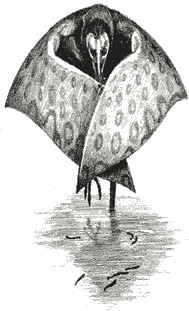
The paraso, Umbrala solitara, is a solitary, bipedal, crane-like pterodactyloid pterosaur from the mixed woodland mangrove swamps of the Indian Subcontinent, in The New Dinosaurs: An Alternative Evolution. Its fishing technique is similar to that of the black heron.
Vast areas of tropical swamp and deltas are found in the Indomalayan ecozone, where great rivers, fed by the snow and glaciers of the mighty Himalayas, wander across the lowlands and empty into the Indian Ocean. Mangrove swamps develop at the ocean's edge on the mud banks built up by debris deposited by the rivers. The mangrove swamp usually blends into the tropical forest on the drier land, and many of the tree creatures that live here are the same as those further inland.
The swamps are home to a great many ray-finned fish and other aquatic animals, particularly those that can withstand the conditions of both saltwater and freshwater. They also support vast numbers of wading birds and pterosaurs that feed on the fish and the mud creatures. The paraso is one of the oddest of such animals. It is a pterosaur that hunts in the shallow lagoons and backwaters of the swamps. It is quite large, with a wingspan of about 3 meters (10 feet). The wing

The paraso, unlike other fishing pterosaurs, is a solitary animal, flying and hunting on its own.

Its head and jaws are very slim, with many tiny sharp teeth. These teeth are typical of a fishing animal, being able to grip slippery fish firmly.
s are brightly colored and make a dazzling display as the pterosaur launches itself into the air and flies off over the swamp. The wings, however, have another function. They are used as a kind of a trap in order to lure and catch fish in a way that is totally unlike any other in the animal kingdom.

Demonstrating its unique fishing action, the paraso wades in the open shallow waters and holds its wings out in a huge fan in front, casting a large shadow over the water. This has two results. First, the fish actively seek out this welcoming shade to escape from the glare of the sun and second, the paraso can see and catch the fish without the distracting reflections on the surface of the water.
